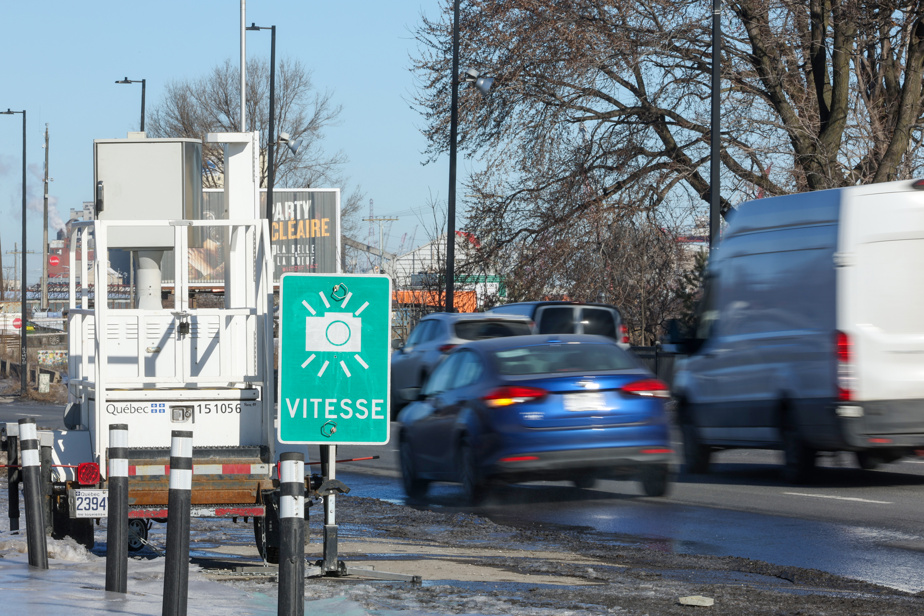The City of Montreal wants to be able to decide for itself the number and location of photo radars on its territory. Concerned for the safety of more vulnerable users, the Plante administration will argue to the government this Wednesday the need to regain control over these devices, in order to increase their number on the island.
“We have been able to show in recent years how proactive we are in terms of calming measures. The needs are immense and radar is a technology that works well. Hence the desire to determine it ourselves, with complete autonomy, since we have the expertise of the territory,” explains the head of mobility on the Montreal executive committee, Sophie Mauzerolle.
It is she who will present this Wednesday the demands of the City, supported by several other actors from the municipal world, during the study of Bill 48 led by the Minister of Transport, Geneviève Guilbault.
In its current form, the minister’s future “National Road Safety Strategy” would remove from the Road Safety Code the obligation that cities have to report to the government on the signage surrounding photo radars, once installed. Quebec would also open the door to the installation of photo radars by the cities themselves, but only in school zones or on active construction sites.
However, the City of Montreal wishes to go further. Valérie Plante’s administration wishes to have complete autonomy over the choice of locations for these photo radars, but above all over their number.
Up to 300 targeted areas
“At the moment, there are 52 photo radars [au Québec], including only 8 in Montreal. Toronto, in comparison, has 75 in total,” slips Mme Mauzerolle, who is concerned about this deficit “while in the City, we have already listed 300 sectors where there are serious collisions attributable to speed and going through red lights.” “We also have 800 school zones, 100 of which are on major arteries,” she insists.
Few months ago, The Press had precisely revealed that Quebec was considering multiplying by six the number of photo radars on the roads of the province, to reach more than 300 in five years, but across Quebec.
According to our information, the government is considering purchasing more modern radars, which make it possible to take a photo of a car in two places on a road, then calculate its average speed based on travel time. This would prevent cars from slowing down until they approach a speed camera.
According to data provided by the City, photo radars reduce speed by 11 km/h on average, in addition to reducing red light traffic by 70%.
“It works, but these devices still need to be frequent, that people are confronted with them on a regular basis,” says the advisor.
CAA-Quebec, for its part, opposes Montreal’s wish. The organization considers that supervision of photo radars must be maintained at the ministerial level “in order to ensure an orderly deployment of these tools”. It is also important, according to the organization, to maintain the government obligation “to analyze the targeted sites […]because such reporting is a guarantee of transparency and social acceptability.”
Should the alcohol level be lowered?
The organization also asked Ms.me Guilbault to lower the alcohol limit allowed while driving to 0.05 mg per 100 ml of blood in his bill. “The effects in other provinces where this rule has been applied for many years have been convincing. There have been improvements in road safety and reductions in fatalities. We’re there,” said Sophie Gagnon, vice-president of public affairs at CAA-Quebec, on Tuesday.
His group says it is “disappointed” to note that “at a time when we aim to reduce deaths and injuries attributable to road accidents”, the bill does not address the issue of alcohol at all. behind the wheel, a “scourge that destroys lives”.
Mme Gagnon wants the government to introduce administrative sanctions when a driver is caught with an alcohol level between 50 mg/100 ml and 80 mg/100 ml. Quebec is the only Canadian province where such sanctions are not applied, she argued.
The opposition parties seem open to this proposal. The liberal Monsef Derraji affirmed that we cannot “respond in a fairly direct way to road safety today” without “talking about drunk driving”. Solidarity activist Étienne Grandmont wondered if Quebec was not “behind” compared to other Canadian provinces and a majority of European countries.
Former police officer André Durocher, now with CAA-Quebec, argued that mentalities have changed and that this measure would make it possible to reach “the mass” of at-fault drivers.
A paid radar in the tunnel
Already the highest paying location on the Quebec road network, the Louis-Hippolyte-La Fontaine tunnel construction site set a new record for fines in January. During this month alone, no less than 6,466 fines were issued for a total of $2.4 million, according to data from the Department of Justice. This increase comes as the Ministry of Transport recently decided to add a second mobile radar to monitor traffic speed. The fines are particularly high because the speed in this motorway portion has been reduced to 50 km/h and the penalties are doubled due to the presence of the construction site. The average fine thus amounted to $376 in January in the tunnel. A sign that this location is lucrative for Quebec, this photo radar alone represented a third of the amounts collected across the province in January.

The flaggers have been waiting “for a long time”
At the Quebec Association of Infrastructure Entrepreneurs, lawyer and general director Caroline Amireault calls on Quebec not to forget the “long-awaited” protection measures for road flaggers, who are also increasingly victims of collisions in the course of their work. Several groups, including the Association of Installers and Signalers of Quebec, have already called for a greater police presence as well as cameras around construction sites. “This bill is an opportunity not to be missed,” says Mme Amireault in this regard.
